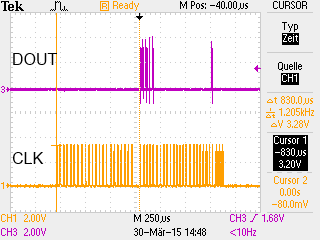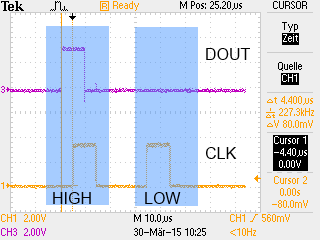You are here: GSI Wiki>Epics Web>EpicsProjectsAndActivities>HardwarePlatforms>HadCon2>HadCon2MultipurposeControlsApi>HadCon2MultipurposeControlsProtocol>HadCon2MultipurposeControlsProtocolCmndApfel>HadConMultipurposeControlsProtocolCmndApfelDetailsOfTheProtocol (2015-05-27, PeterZumbruch)Edit Attach

Apfel - Details Of The Communication Protocol
Introduction
The communication with the APFEL chip on the signal levelMain
- DOUT low + CLK low
- DOUT high + CLK low
- DOUT high + CLK high
- DOUT low + CLK high
- DOUT low + CLK low
- DOUT low + CLK low
- DOUT high + CLK low
- DOUT high + CLK high
- DOUT low + CLK high
- DOUT low + CLK low
- ~25μs per bit
- → max 40kBit/s
- or 5μs per state change
- + 10μs
- → max 28kBit/s
- using artificial markers before and after the parser give
- a minimum of ~37μs per call
- typical values of ~1.2ms (w/o any output)
- typical values of ~12 ms (with output)
- typical values of ~15 ms (with error output)
- maximum 125ms (autocalibration)
- BIG - endian
- stream header
- the actual command sequence
- command specific sequences
- clear data input sequence, i.e.
- for each command sequence bit (22)
- write 1 clock sequence:
- equivalent to: write 1 low bit
- each 8 bit with 2 additional sequences of
- DOUT low + CLK low
- write 1 clock sequence:
- followed by 10 sequences of the same
- DOUT low + CLK low
- ⇒ summed up roughly ~620μs
- ⇒ measured ~620μs ~760-840μs
- for each command sequence bit (22)
- the set
- DOUT low + CLK low
- to allow side selection bit to change before any action
- DOUT low + CLK low
- the sequence
- DOUT low + CLK low
- DOUT high + CLK low
- DOUT high + CLK high
- DOUT high + CLK low ⇐ this is the only difference to a low bit sequence
- DOUT low + CLK low
- 4 command bits
- 10 value bits
- 8 chip id bits
- 3 clock cycles
- equivalent to 3 low bit sequences
- (optional) the complete readDac sequence
- read bit sequence for
- 2 leading bits
-
 this have to be
this have to be 10(binary), to be correct
-
- 10 value bits
- 3 trailing bits
-
 this have to be
this have to be 111(binary), to be correct
-
- so in total a bit stream of the form of
10 xx xxxx xxxx 111has to be read
- 2 leading bits
- followed by 3 clock cycles
- equiv. to 3 low bit
- DOUT low + CLK low
- Initial bit and the rest
- Initial bit
- since the APFEL needs first the falling clock endge to activate the output pad, the initial bit is read differently
- CLK high
- CLK low
- read PIN
- Remaining bit
- CLK high
- read PIN
- CLK low
- Initial bit
- 4 × 1024 = 4096 clock cycles
- 3 clock cycles
- 3 clock cycles
- command
set amplification -

Bits
Bits are represented by a sequence of 5 states of the pins DOUT and CLKHigh
Low
Measurements

execution times of the api
Endianness
commands
-
The full command sequence consists of:
stream header
-
The actual command sequence is prefixed by a stream header consisting of
command sequence
-
The bare command set of the APFEL protocol is a big-endian sequence of 22 bits:
command specific sequences
setDac
readDac
read bit sequence
auto calibration
test pulse - sequence
set/reset amplification
Example
-- PeterZumbruch - 31 Mar 2015
-- PeterZumbruch - 2015-05-27
| I | Attachment | Action | Size | Date | Who | Comment |
|---|---|---|---|---|---|---|
| |
Bits.png | manage | 5 K | 2015-03-31 - 09:43 | PeterZumbruch | Bit timing |
| |
CommandSequence.png | manage | 5 K | 2015-03-30 - 16:08 | PeterZumbruch | Apfel command sequence for Command E |
Edit | Attach | Print version | History: r5 < r4 < r3 < r2 | Backlinks | View wiki text | Edit wiki text | More topic actions
Topic revision: r5 - 2015-05-27, PeterZumbruch
- User Reference
- BeginnersStartHere
- EditingShorthand
- Macros
- MacrosQuickReference
- FormattedSearch
- QuerySearch
- DocumentGraphics
- SkinBrowser
- InstalledPlugins
- Admin Maintenance
- Reference Manual
- AdminToolsCategory
- InterWikis
- ManagingWebs
- SiteTools
- DefaultPreferences
- WebPreferences
- Categories
 Copyright © by the contributing authors. All material on this collaboration platform is the property of the contributing authors.
Copyright © by the contributing authors. All material on this collaboration platform is the property of the contributing authors. Ideas, requests, problems regarding GSI Wiki? Send feedback | Legal notice | Privacy Policy (german)


